Canon CR-2 User Manual
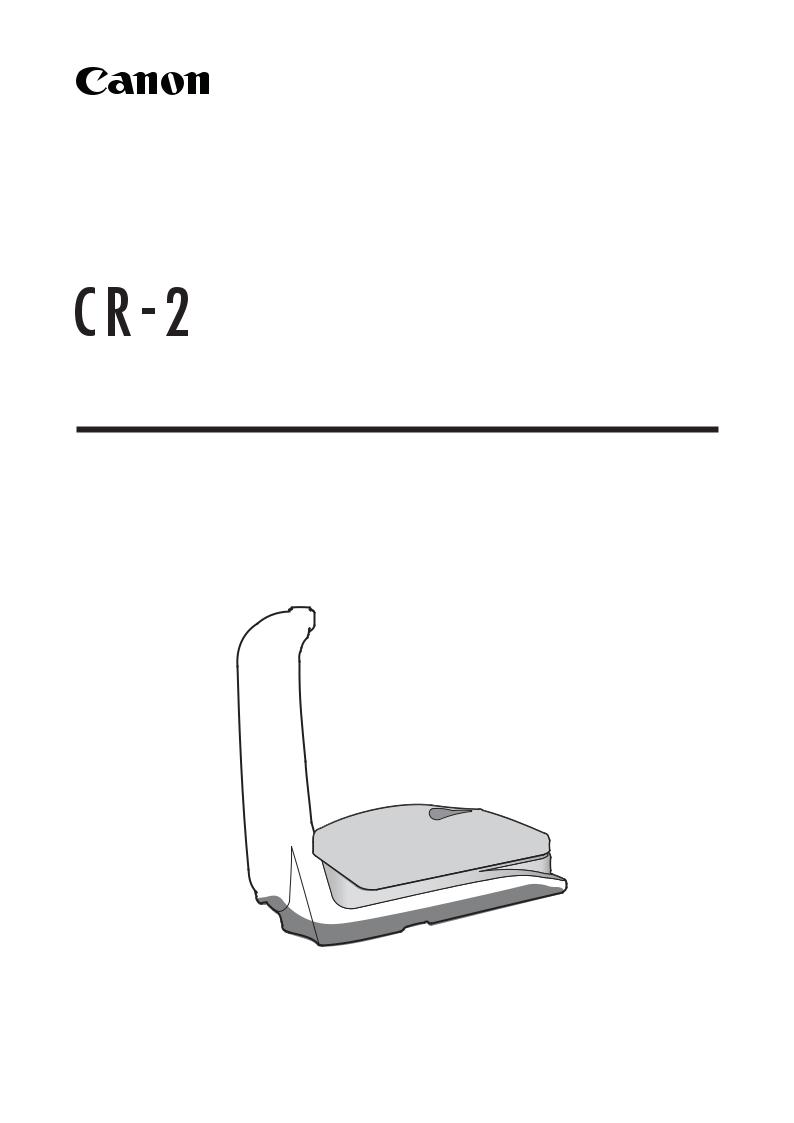
Digital Retinal Camera
Operation Manual
Make sure you read this manual before using the instrument.
Keep this manual in a safe place so that you can use it in the future.

Thank you for purchasing the Canon Digital Retinal Camera CR-2 (referred to as “CR-2” in this manual). The operation manuals for this instrument consist of the “Digital Retinal Camera CR-2 Operation Manual” and the “Retinal imaging control software NM 2 Operation Manual.” Be sure to read these manuals thoroughly before using the instrument, and apply the information that you learn.
Important
•The CR-2 must only be used by a doctor or a legally qualified person.
•The user is responsible for managing the usage and maintenance of medical equipment. We suggest that a dedicated individual is assigned responsibility for maintenance to ensure that the CR-2 is kept in good condition and can be used safely.
•Rx Only (USA) Federal law restricts this device to sale by or on the order of a physician.
Disclaimers
•Canon takes no responsibility for damage that occurs due to fires, earthquakes, third party actions, other accidents, the user's deliberate misuse, negligence, experimentation, or use under other abnormal conditions.
•Canon takes no responsibility for direct or consequential damages resulting from the use or the inability to use the CR-2. In addition, no compensation is available for lost image data, regardless of the cause of the loss of the image data.
•Canon takes no responsibility for injuries or property damage that may occur if safety precautions are not followed or the instrument is used for something other than its intended purpose.
•Medical examinations are the responsibility of a doctor. Canon takes no responsibility for diagnostic results.
•The user is responsible for maintaining the confidentiality of image data and must follow the laws relating to the production, processing, analysis, and storage of medical images.
•The information in this manual may be changed without prior notice.
•Although we have made every effort to ensure the accuracy of the information in this manual, if you have any questions regarding the contents, please contact your sales representative or local Canon dealer.
Installation
• Request your sales representative or local Canon dealer to install the CR-2.
Trademarks
•Canon and the Canon logo are trademarks of Canon Inc.
•Other system names and product names that appear in this manual are trademarks of their respective companies.
Copyright
•The copyright of this manual belongs to Canon Inc.
•Unauthorized reproduction, duplication, or reprinting of this manual in whole or in part is prohibited.
2

Contents
1 Introduction................................................................................................. |
4 |
Features...................................................................................................... |
4 |
Indications for Use ..................................................................................... |
4 |
Checking Included Items ........................................................................... |
5 |
Conventions Used in This Manual ............................................................ |
6 |
2 Safety ........................................................................................................... |
7 |
Regulatory Information............................................................................... |
7 |
Safety Precautions ..................................................................................... |
9 |
Notes on Using CR-2 ............................................................................... |
13 |
Rating Label Display ................................................................................ |
16 |
3 Names of Parts ......................................................................................... |
17 |
Retinal Camera ........................................................................................ |
17 |
Operation Panel ....................................................................................... |
19 |
Observation Monitor ................................................................................ |
20 |
4 Basic Operations ...................................................................................... |
21 |
Flow of Operation .................................................................................... |
21 |
Connecting Cables .................................................................................. |
22 |
Preparing for an Examination................................................................... |
22 |
Patient Setup............................................................................................ |
24 |
Alignment ................................................................................................ |
25 |
Photography ............................................................................................. |
28 |
Finishing an Examination ........................................................................ |
29 |
5 Photography Auxiliary Functions ........................................................... |
30 |
x2 Photography ........................................................................................ |
30 |
Small Pupil Photography Function........................................................... |
30 |
Diopter Compensation ............................................................................. |
31 |
Anterior Segment Photography ............................................................... |
32 |
External Monitor....................................................................................... |
32 |
6 Maintenance.............................................................................................. |
34 |
Daily Inspections ..................................................................................... |
34 |
Cleaning the Objective Lens ................................................................... |
35 |
Cleaning the Image Sensor ..................................................................... |
36 |
Cleaning the Outside of the CR-2 ........................................................... |
36 |
Disinfecting the Forehead Rest................................................................ |
37 |
Refilling Chin Rest Paper ......................................................................... |
37 |
Attaching and Removing the Digital Camera .......................................... |
37 |
7 Troubleshooting........................................................................................ |
40 |
Appendix....................................................................................................... |
42 |
Specifications .......................................................................................... |
42 |
EMC (Electromagnetic Compatibility)...................................................... |
43 |
Warranty and Repair Service .................................................................. |
48 |
3

1Introduction
Features
The Canon Digital Retinal Camera CR-2 takes digital photographic retinal images of patient’s eyes across an angle of view of 45 degrees, in a naturally dilated state without using mydriatics. The CR-2 has the following features:
Reduced flash intensity
The CR-2 can take images at ISO 800/1600 at the standard flash intensity, and ISO 3200/6400 in low flash intensity mode. This reduces patient discomfort caused by light glare.
Compact, user-friendly design
The CR-2 is designed to be even smaller, more lightweight and compact than the previous model. This makes it easier to assist patients and provides significant ease of operation.
An operation lever has the integrated functions: vertical movement of the main unit, switching between anterior segment and fundus, and manual focusing. This lever significantly improves alignment operability.
Special digital camera
The CR-2 is equipped with a special digital camera using EOS digital technology. This enables the CR-2 to fully maximize Canon technology for shooting high-quality, high-resolution diagnostic images.
Small pupil photography function
The CR-2 captures retinal images through pupils of the normal diameters from 4.0 mm. This small pupil photography function permits image to be captured through pupils from 3.3 mm in diameters.
System optimized for digital photography
With the supplied imaging control software, the photographed images can be browsed, processed, stored, output to the DICOM storage server, exported in DICOM or JPEG format and output to a printer.
In this manual, the operation procedure is described with the Retinal imaging control software NM 2 (referred to as “Rics NM 2” ).
Indications for Use
For USA
The device is intended to be used for taking digital images of the retina of the human eye without a mydriatic.
For European Union
This medical device is intended to observe and record images of retinal fundus through the pupil without making contact with subject’s eye for the purpose of diagnosis by way of producing fundus image information.
4
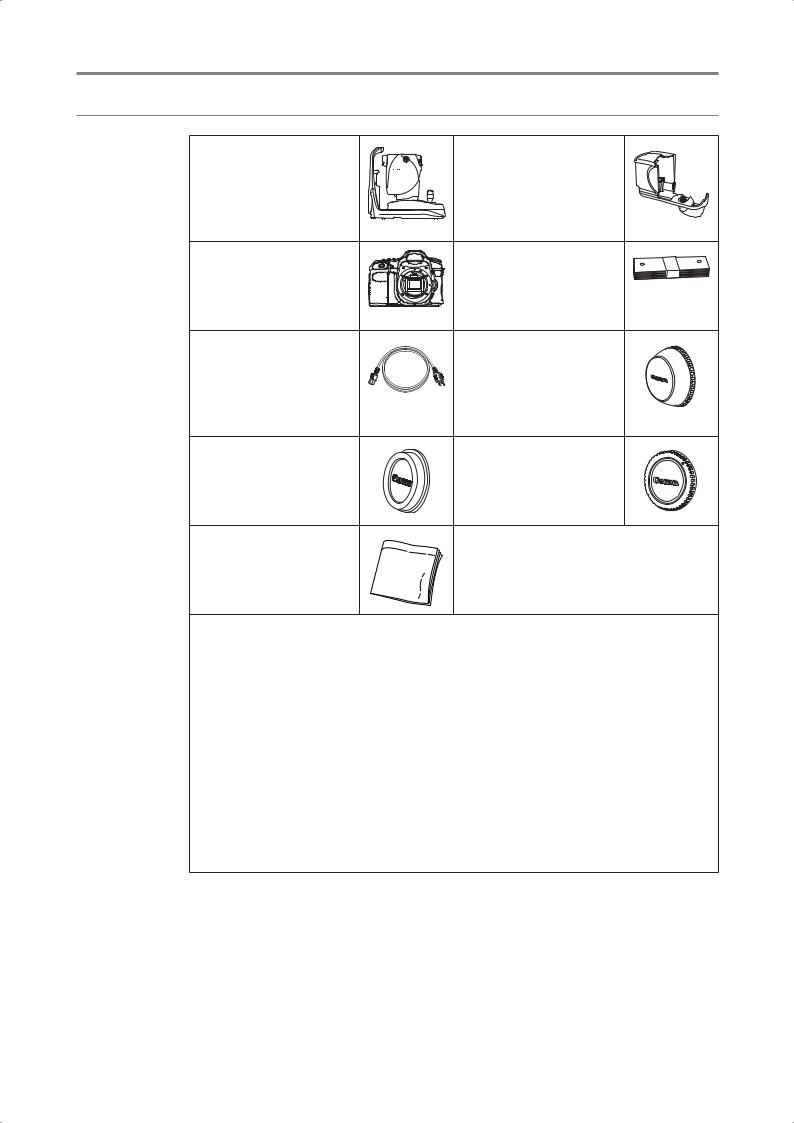
1 Introduction
Checking Included Items
Digital Retinal Camera CR-2 |
Digital camera cover |
Main unit |
Protects the cable that is |
|
connected to the digital |
|
camera. |
Digital camera |
Chin rest paper |
Digital camera specialized for |
100 sheets provided. |
the CR-2. |
|
Power cord |
Objective lens cap |
Connects the CR-2 to an AC |
Initially covers the objective |
outlet. (3 m) |
lens. |
USA and Canada only: |
|
Plug type: VM0275 Hospital- |
|
Grade |
|
Camera mount cap |
Body cap |
Initially covers the camera |
Initially covers the mount on |
mount on the retinal camera. |
the digital camera. |
Dust cover |
|
Use it to cover the CR-2 when |
|
it's not being used. |
|
Operation Manual for the CR-2—this document
Describes the handling precautions and operating instructions for the CR-2.
CD-ROM—Retinal imaging control software NM 2
Contains the Retinal imaging control software NM 2 (Rics NM 2), which is used to record, view and store photographed images taken with the CR-2.
Operation Manual for the Retinal imaging control software NM 2
Describes the procedures for operating the Rics NM 2.
DICOM Conformance Statement
DICOM Conformance Statement for the Rics NM 2.
Warranty Card (for USA model only)
WEEE Directive Leaflet (for EU model only)
Installation Report
Optional products
External eye fixation lamp
Chin rest paper—500 sheets
5

1 Introduction
Conventions Used in This Manual
Symbols to indicate safety precautions
This manual uses the following symbols to indicate safety precautions that are important for using the CR-2 safely. Always follow the advice in these safety precautions.
WARNING |
A warning that incorrect operation may result in death or serious injury. |
|||
|
||||
|
|
|
|
|
CAUTION |
A caution that incorrect operation may result in serious injury. |
|||
|
||||
|
|
|
|
|
CAUTION |
A caution that incorrect operation may break the CR-2 or damage other |
|||
devices. |
||||
|
|
|
||
|
|
|
|
|
|
|
|
This symbol indicates actions that must not be taken (prohibited actions). |
|
|
|
|
|
|
|
|
|
This symbol indicates actions that must be taken. |
|
|
|
|
|
|
|
|
|
This symbol indicates important advice that we strongly recommend be |
|
|
|
|
||
|
|
|
followed while operating the CR-2. |
|
|
|
|
||
|
|
|
|
|
|
|
|
This symbol indicates supplementary explanations or advice for operating the |
|
|
|
|
CR-2. |
|
|
|
|
|
|
References
This manual uses the following style to indicate reference destination.
Example: (see page 15)
6

2Safety
Regulatory Information
The following sections list the classifications applicable to the CR-2 and the directives and standards that the CR-2 complies with.
Device Classification
Protection against electric shock |
Class I equipment |
Degree of protection against electric shock |
Type B applied parts |
Degree of protection against ingress of water |
IPX0 |
Degree of safety of application in the presence of a |
Not suitable |
flammable anaesthetic mixture with air or with oxygen or |
|
nitrous oxide |
|
Mode of operation |
Continuous operation |
Directives and Standards
USA and Canada
UL 60601-1 |
Medical electrical equipment – Part 1: General |
CAN/CSA C22.2 No.601.1 |
requirements for safety |
IEC 60601-1: 1988+A1: 1991+A2: 1995 |
|
IEC 60601-1: 2005 |
|
IEC 60601-1-1: 2000 |
Medical electrical equipment – Part 1-1: General |
|
requirements for safety – Collateral standard: Safety |
|
requirements for medical electrical systems |
IEC60601-1-2: 2001+A1: 2004 |
Medical electrical equipment – Part 1-2: Collateral |
|
standard: Electromagnetic compatibility – Requirements |
|
and tests |
IEC 60601-1-4: 1996+A1: 1999 |
Medical electrical equipment – Part 1-4: Collateral |
|
standard: Programmable electrical medical systems |
ISO 15004-1: 2006 |
Ophthalmic instruments – Part 1: General requirements |
|
applicable to all ophthalmic instruments |
ISO 15004-2: 2007 |
Ophthalmic instruments – Part 2: Light hazard protection |
ISO 10993-1: 2009 |
Biological evaluation of medical devices – Evaluation and |
ISO 10993-5: 2009 |
testing |
ISO 10993-10: 2009 |
|
7

2 Safety
European Union
93/42/EEC |
Medical Device Directive |
EN 60601-1: 1990+A1: 1993+A2: 1995 |
Medical electrical equipment – Part 1: General |
EN 60601-1: 2006 |
requirements for safety |
IEC 60601-1-1: 2001 |
Medical electrical equipment – Part 1-1: General |
|
requirements for safety – Collateral standard: Safety |
|
requirements for medical electrical systems |
EN 60601-1-2: 2007 |
Medical electrical equipment – Part 1-2: Collateral |
|
standard: Electromagnetic compatibility – Requirements |
|
and tests |
IEC60601-1-4: 1996+A1: 1999 |
Medical electrical equipment – Part 1-4: General |
|
requirements for safety – Collateral standard: |
|
Programmable electrical medical systems |
EN 60601-1-6: 2004 |
Medical electrical equipment – Part 1-6: General |
|
requirements for safety – Collateral standard: Usability |
IEC 62304: 2006 |
Medical device software – Software life-cycle processes |
EN 62366: 2008 |
Medical device – Application of usability engineering to |
|
medical devices |
EN ISO 14971: 2009 |
Medical device – Application of risk management to |
|
medical devices |
EN ISO 15004-1: 2009 |
Ophthalmic instruments – Part 1: General requirements |
|
applicable to all ophthalmic instruments |
ISO 15004-2: 2007 |
Ophthalmic instruments – Part 2: Light hazard protection |
EN ISO 10993-1: 2009 |
Biological evaluation of medical devices – Evaluation and |
EN ISO 10993-5: 2009 |
testing |
EN ISO 10993-10: 2009 |
|
Deutschland
Während des Betriebs liegt der Schalldruckpegel dieses Instruments bei 70 dB(A) oder weniger gemäß EN ISO 7779.
8

2 Safety
Safety Precautions
To prevent injuries and data loss, operate the CR-2 correctly by following the safety precautions.
WARNING |
|
To avoid the risk of electric shock, this equipment must only |
|
be connected to a supply mains with protective earth. |
|
|
|
|
|
|
|
|
|
Do not damage the power cord. |
|
Prohibited |
• Do not place anything heavy onto the power cord. |
|
• Do not damage or modify the power cord. |
|
|
|
|
|
|
• Do not forcibly bend, twist or pull the power cord. |
|
|
• Do not hold the power cord when removing it from the AC outlet. Be sure to hold |
|
|
the plug. |
|
|
Handle the power cord carefully. If the cord is damaged, contact your sales |
|
|
representative or local Canon dealer. A damaged cord may result in fire or electric |
|
|
shock. |
|
|
|
|
|
Do not use a multiple power strip and an extension cable. |
|
Prohibited |
Connect the power cord directly to the AC outlet. Do not use a multiple power strip |
|
and an extension cable with it. |
|
|
|
|
|
|
|
|
|
Do not disassemble or modify. |
|
Prohibited |
A disassembled or modified instrument may result in fire or electric shock. Because |
|
the CR-2 incorporates high-voltage parts that may cause electric shocks, touching |
|
|
|
|
|
|
them may cause death or serious injury. |
|
|
|
|
|
Do not leave alcohol, thinner, or any flammable chemicals |
|
|
near the instrument. |
|
Prohibited |
Do not place the CR-2 near a flammable solvent. Fire may result if the solvent spills |
|
|
|
|
|
or evaporates and makes contact with the internal electric parts. Some disinfectants |
|
|
are flammable. Be sure to take precautions when using them. |
|
|
|
|
|
Stop using immediately if there is an abnormality or problem. |
|
|
If an abnormality occurs, immediately turn off the power and |
|
|
disconnect the plugs on all devices. |
|
|
• Smoke is emitted |
|
|
• An unusual smell |
|
|
• An unusual noise |
|
|
• Foreign matter gets inside |
|
|
• Devices are damaged. |
|
|
Fire or electric shock may result if you continue using in such conditions. |
|
|
Immediately turn off the power of CR-2, unplug the power plug and turn off the |
|
|
power of all connected devices. Then, contact your sales representative or local |
|
|
Canon dealer immediately. |
|
|
|
|
|
Do not place anything on top of the device. |
|
Prohibited |
Fire or electric shock may result if water or any other liquid or a needle, paper clip or |
|
any foreign matter gets inside the CR-2. |
|
|
|
|
|
|
|
9

2 Safety
WARNING |
|
Do not use a power supply voltage other than that specified |
|
on the rating label. |
|
|
|
|
|
Prohibited |
Do not use any power cord other than the one supplied. |
|
|
|
|
|
Use the power voltage specified on the rating label. Otherwise, fire or electric shock |
|
|
may result. |
|
|
The supplied power cord is designed exclusively for this product. Do not use any |
|
|
other power cord. |
|
|
|
|
|
Do not plug or unplug the power plug with wet hands. |
|
Prohibited |
Do not plug or unplug the power plug or handle any other parts with wet hands. |
|
Otherwise, fire or electric shock may result. |
|
|
|
|
|
|
|
|
|
Unplug the plug periodically and remove any dust or dirt |
|
|
around the plug and the AC outlet. |
|
|
If the cord is kept plugged in for a long time in a dusty, humid or sooty environment, |
|
|
dust around the plug will attract moisture, resulting in possible insulation failure that |
|
|
may result in a fire. |
|
|
|
|
|
Insert the power plug completely. |
|
|
Insert the power plug completely into the AC outlet. If a pin of the power plug makes |
|
|
contact with metal or any conductive object, fire or electric shock may result. |
|
|
|
|
|
Do not clean the CR-2 with flammable solvent. |
|
Prohibited |
For safety reasons, before cleaning the CR-2, be sure to turn off the power of all the |
|
devices and unplug the power cord from the AC outlet. Do not use alcohol, benzine, |
|
|
|
|
|
|
thinner or any other flammable solvent. |
|
|
Otherwise, fire or electric shock may result. |
|
|
|
|
|
Turn off the power before inspection. |
|
|
For safety reasons, before inspecting the instrument or cables, be sure to turn off |
|
|
the power of all the devices. |
|
|
Otherwise, electric shock may result. |
|
|
|
|
|
Do not play the supplied CD-ROM in any CD player that does |
|
|
not support data CD-ROMs. |
|
Prohibited |
Playing the CD-ROM in an audio CD player may damage the speaker. Playing the |
|
|
|
|
|
CD-ROM in an audio CD player may also cause hearing loss if listened to with |
|
|
headphones. |
|
|
|
|
|
Be sure to turn off the power before moving the CR-2. |
|
|
Before moving the CR-2, make sure that the power is turned off, the power |
|
|
plug is removed from the AC outlet, and any cables that are connected to other |
|
|
devices are disconnected. |
|
|
|
|
|
Do not touch conductive parts of non-medical equipment and |
|
|
the patient simultaneously. |
|
Prohibited |
Otherwise, electric shock may result. |
|
|
Use an isolation transformer when this system is connected to a network.
Connect an isolation transformer conforming to IEC 60601-1 for networks between the computer and HUB.
Otherwise, there is a risk of electric shock if the network is faulty.
10
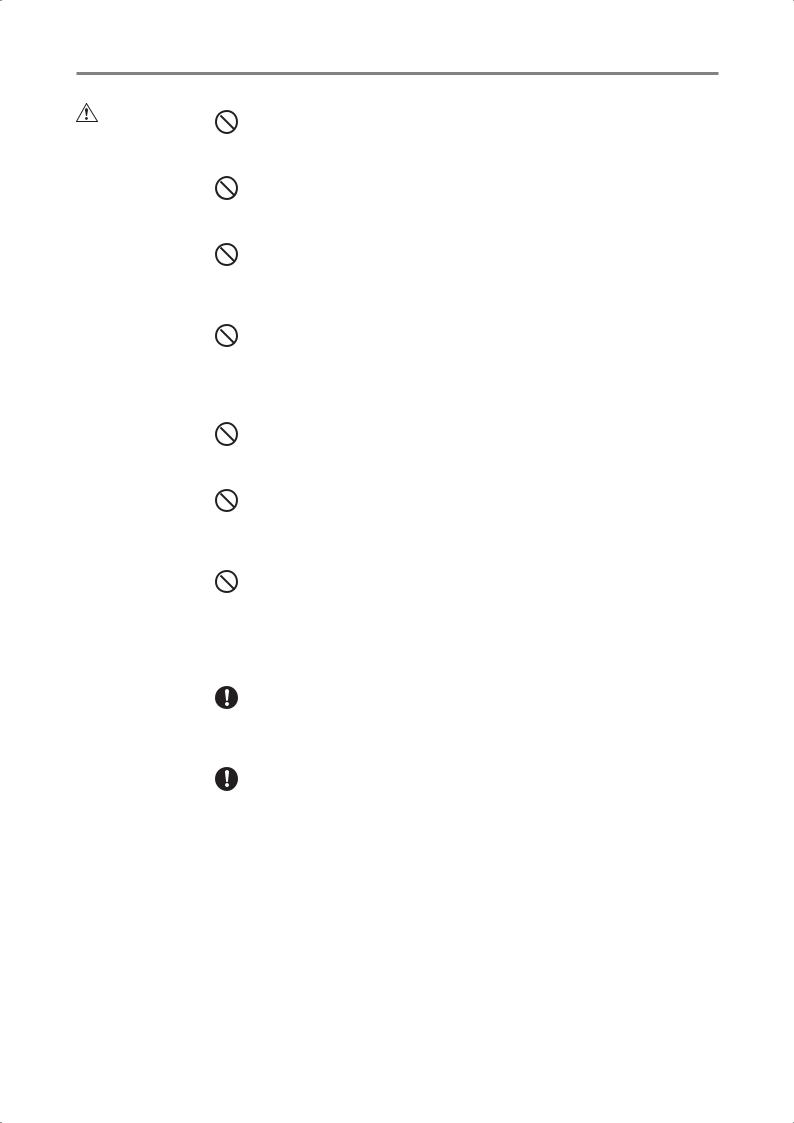
2 Safety
CAUTION |
|
Do not install in locations exposed to water, steam, moisture |
|
or dust. |
|
|
|
|
|
Prohibited |
Doing so may cause problems or malfunctions. |
|
|
|
|
|
|
|
|
Do not install in locations exposed to salt, sulfur or corrosive |
|
|
gas. |
|
Prohibited |
Doing so may result in corrosion of the instrument, problems or malfunctions. |
|
|
|
|
|
|
|
|
Do not install in locations that are unstable or exposed to |
|
|
vibration. |
|
Prohibited |
The vibration may knock over the instrument or the instrument may become |
|
|
|
|
|
unbalanced and fall, resulting in a malfunction or injury. |
|
|
|
|
|
Do not place anything near the power plug. |
|
Prohibited |
To make it easy to unplug the power plug at any time, avoid putting any obstructions |
|
near the AC outlet. |
|
|
|
|
|
|
Fire or electric shock may result if the power plug is not unplugged during an |
|
|
emergency. |
|
|
|
|
|
Do not block the vent holes. |
|
Prohibited |
Doing so may cause the internal temperature to rise and result in fire. |
|
|
|
|
|
|
|
|
Do not place your hands or fingers on the base. |
|
Prohibited |
Your hand or fingers may be pinched and injured when the stage moves to either |
|
side. |
|
|
|
|
|
|
Similarly, instruct the patient not to place his/her hands or fingers on the base. |
|
|
|
|
|
Do not hold the head rest or digital camera when moving the |
|
|
CR-2. |
|
Prohibited |
When carrying the CR-2, be sure to tighten the stage lock, hold the carrying |
|
|
|
|
|
indentations at the front and rear of the base panel, and keep the CR-2 level. Do not |
|
|
hold it by the digital camera or the head rest or any other parts, as they may come |
|
|
off and result in injury. |
|
|
|
|
|
Hold the CR-2 when connecting or disconnecting a cable. |
|
|
For safety reasons, when connecting or disconnecting the power cord or any cable, |
|
|
be sure to hold the main unit. Otherwise, the main unit may fall over, possibly |
|
|
causing injury. |
|
|
|
|
|
Ensure that the entire system conforms to IEC 60601-1-1. |
|
|
Use the computer, monitor, and other equipment that conform to the system |
|
|
standard IEC 60601-1 or IEC 60950-1 for the Digital Retinal Camera CR-2. Be sure |
|
|
that the entire system conforms to IEC 60601-1-1. Be sure to also use an isolation |
|
|
transformer conforming to IEC 60601-1 when a computer or monitor conforming to |
|
|
IEC 60950-1 is used. |
|
|
Otherwise, electric shock may occur. For details, please contact your sales |
|
|
representative or local Canon dealer. |
|
|
|
11
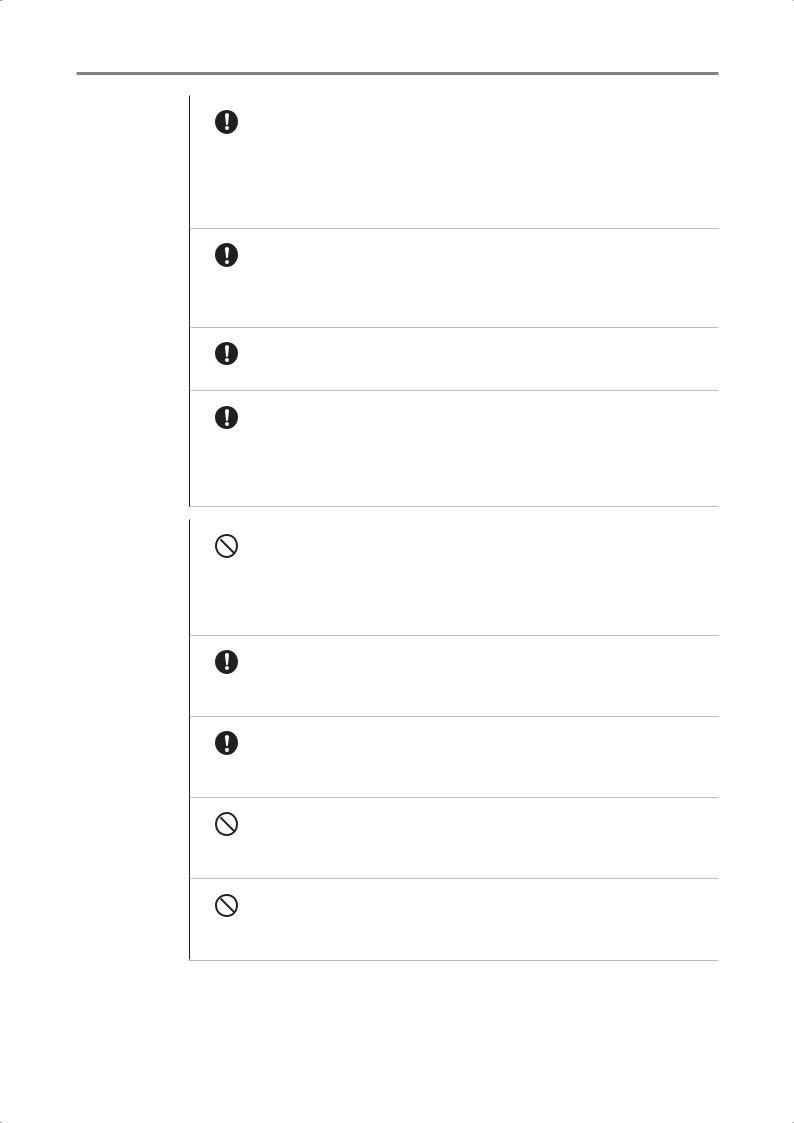
2 Safety
 CAUTION
CAUTION
CAUTION
Keep the forehead rest and chin rest clean.
To prevent the risk of infection, wipe the forehead rest with disinfectant ethanol for each patient. To ensure cleanliness, replace the chin rest paper for each patient. If the chin rest paper is not being used, be sure to disinfect the chin rest for each patient.
For details on how to disinfect, consult a specialist. The forehead rest may be corroded if a disinfectant other than those above is used.
Slowly move the main unit towards the patient’s eye when taking an image.
When adjusting the position of the main unit in the front-back direction, slowly bring the main unit closer to the patient while looking at the patient’s eye from the side. The patient’s eye may be injured if the objective lens makes contact with it.
Check the image before using the CR-2.
Before using the CR-2, be sure to take a test image to ensure that there is no foreign matter present that can affect image readings or diagnosis.
Be sure to turn off the power when not in use.
For safety reasons, be sure to turn off the power of all the devices when the CR-2 is not being used.
Also, remove the power plug from the AC outlet and put on the cover when the CR-2 is not going to be used for a long time.
Otherwise, dust or any foreign matter may accumulate and result in fire.
Do not touch the main unit or the chin rest while they are moving.
Prohibited |
The main unit and the chin rest move to the center position when the CR-2 main |
|
|
|
unit is turned on or a study is finished with the control software. Do not touch the |
|
main unit or the chin rest while they are moving. Keep the patient’s chin away from |
|
the chin rest. |
Before packing the CR-2, return the main unit and chin rest to their initial positions.
Lower the main unit and chin rest to the bottom. To automatically lower them, turn on the power while holding down the set button.
Inspect daily and periodically.
For safety reasons, before using the CR-2, be sure to perform the daily inspection. Have a periodically inspection performed for the CR-2 at least once a year by a Canon designated representative to maintain its performance and reliability.
Do not turn off the CR-2 or the computer during image capture, data transfer, or backup.
Prohibited |
Doing so might damage the computer or corrupt the data. |
|
Do not disconnect the cable between the CR-2 and the computer during image capture or data transfer.
Prohibited |
Doing so might damage the computer or corrupt the data. |
|
12

2 Safety
Notes on Using CR-2
Digital camera
•The attached digital camera is designed for the CR-2. The specifications differ from commercially available Canon digital cameras. Use only for observing and taking photographs of peoples’ eyes. Do not detach the digital camera from the main unit to use separately. Otherwise, failure of the CR-2 may result.
•If any problems occur or repairs are needed with the CR-2’s digital camera, contact your sales representative or local Canon dealer.
Before use
•Inspect the CR-2 daily. Make sure that no foreign matter is present that can affect image readings or diagnoses.
•Check and clean the objective lens before taking an image. Any stains or scratches on the objective lens will appear as white spots.
•Sudden heating of a room during winter or in cold regions may cause condensation to form on the objective lens or on optical parts inside the CR-2. In this case, wait until condensation disappears before taking images.
•Do not touch the lens of the retinal camera or the mirror of the digital camera when attaching and detaching the digital camera from the retinal camera. If any dirt, fingerprints, dust, or other foreign objects are on the lens or mirror, you will not be able to take a good image.
After use
•After using the CR-2, turn off the power, cover the objective lens with the objective lens cover to protect it from dust, and place the dust cover over the CR-2. You cannot take good images if the objective lens is dusty.
•If the digital camera is detached and left unattached, dirt and dust may enter the retinal camera and the digital camera. Be sure to always attach the caps to their respective mounts.
Cleaning and disinfection
•Do not allow the blower to touch the lens.
•Do not wipe or rub the lens if there is dirt or dust on it. Doing so could scratch the lens.
•Do not wipe the lens with disinfectant ethanol, eyeglass cleaner, or silicone-coated paper. Doing so could corrode the surface of the lens or leave streaks.
•Do not clean the outside of the CR-2 with a lens cleaner. Doing so could damage the outside of the CR-2.
•Never use alcohol, benzine, thinner, or other solvents to clean the outside of the CR-2. Doing so damages the outside of the CR-2.
•Never use disinfectant ethanol to clean the outside of the CR-2, with the except of the forehead rest and the chin rest. Doing so damages the outside of the CR-2.
•If the chin rest paper is not being used, disinfect the chin rest for each patient in the same manner as you do for the forehead rest.
•Carry out all cleaning, sterilization and disinfection procedures specified in the instruction manual for each peripheral device in the system.
13

2 Safety
Environment of use
•Use, store, and transport the CR-2 in an environment that is within the range of the following conditions. Use the original packaging to store or ship it.
|
Temperature |
Humidity |
Atmospheric pressure |
|
|
|
|
Environment of use |
10 to 35°C |
30 to 90% RH (no |
700 to 1060 hPa |
|
|
condensation) |
|
Storage and transportation |
–30 to 50°C |
10 to 95% RH (no |
700 to 1060 hPa |
environment |
|
condensation) |
|
|
|
|
|
•Do not install, store, or leave the CR-2 in a very hot or humid environment. Also, do not use the CR-2 outside. Doing so may cause a malfunction or misoperation.
•Always try to keep the room as clean as possible. After many years of usage, airborne dust in the room may get on the objective lens as well as the optical parts in the main unit. You cannot take good images if dust is on the equipment.
•When the CR-2 is not being used, attach the objective lens cap and place the dust cover over the CR-2.
Installation
•Request your sales representative or local Canon dealer to install the CR-2.
•A strong shock to the CR-2 may put it out of alignment. Please handle the unit carefully.
Transportation
•Lower the main unit and chin rest to the bottom. To automatically lower them, turn on the power while holding down the set button.
•Be sure to turn off the CR-2’s power switch, remove the AC plug from the outlet, and disconnect any cables connected to other equipment.
•When lifting the main unit, do not hold the head rest or digital camera. Hold the main unit by the indentations for lifting at its front and rear, and keep it level.
•When transporting the CR-2, align the stage with the base, and then lock the stage with the stage lock lever.
•The CR-2 needs to be protected from vibration and shocks when it is transported in a vehicle or over long distances. For details, contact your representative or local Canon dealer.
14

2 Safety
Disposal
Disposal of this product in an unlawful manner may have a negative impact on human health and on the environment. Therefore, when disposing of this product, be absolutely certain to follow the procedure which conforms with the laws and regulations applicable to your area.
European Union (and EEA*) only
This symbol indicates that this product is not to be disposed of with your household waste, according to the WEEE Directive (2002/96/EC) and your national law. This product should be handed over to a designated collection point, e.g.,
on an authorized one-for-one basis when you buy a new similar product or to an authorized collection site for recycling waste electrical and electronic equipment (EEE). Improper handling of this type of waste could have a possible negative impact on the environment and human health due to potentially hazardous substances that are generally associated with EEE. At the same time, your cooperation in the correct disposal of this product will contribute to the effective usage of natural resources. For more information about where you can drop off your waste equipment for recycling, please contact your local city office, waste authority, approved WEEE scheme or your household waste disposal service.
For more information regarding return and recycling of WEEE products, please visit
www.canon-europe.com/WEEE.
* EEA: Norway, Iceland and Liechtenstein
15
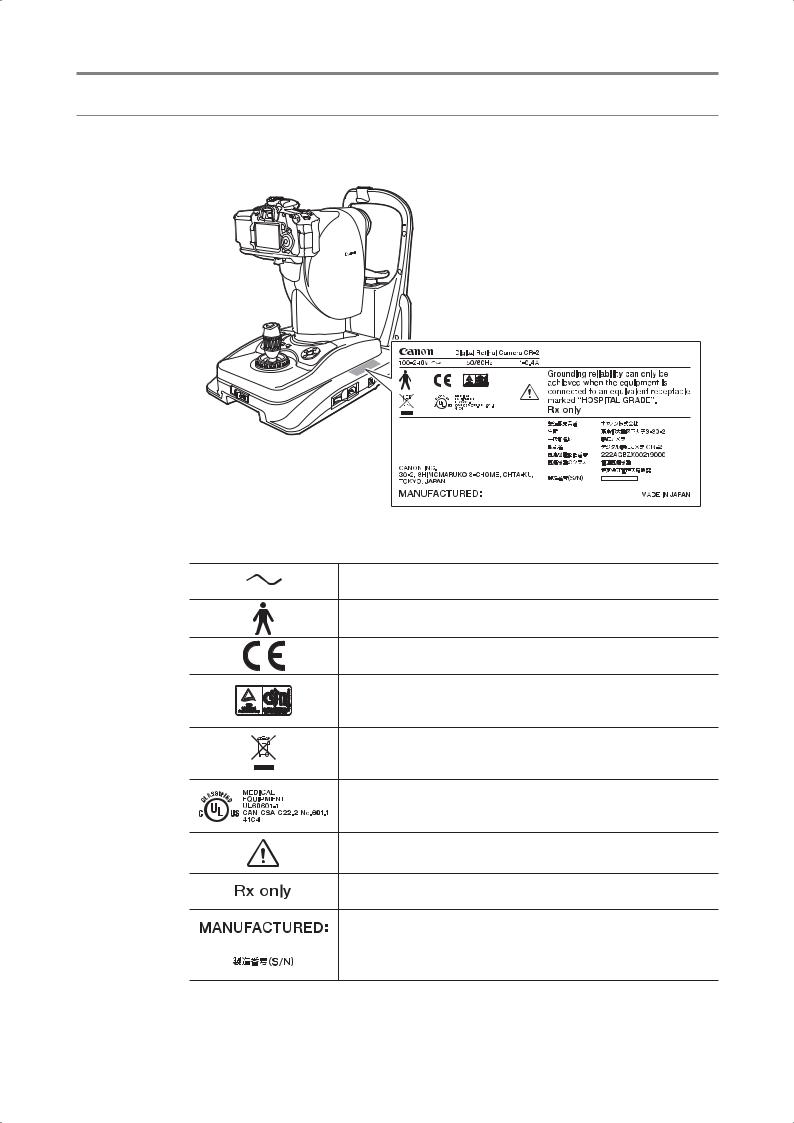
2 Safety
Rating Label Display
The position and contents of the label attached on the CR-2 is shown below.
Follow the information on the label to use the CR-2 appropriately.
The following table describes the marks and indications on the rating label.
Alternating current
Type B
Class I device indicating manufacturer’s declaration of conformance with the Annex VII of the Medical Device Directive, 93/42/EEC
Certification mark that shows the product has passed the tests by
TUV Rheinland of conformity with the medical device regulations in the
European Union.
Product that WEEE directive, Directive on Waste Electrical and Electronic Equipment, 2002/96/EC, requires separate collection. The directive is effective in the European Union only.
Certification mark that indicates the product complies with UL 60601- 1 and CAN/CSA 22.2 No. 601.1, that specifies protection against fire, electric shock, and mechanical hazards
Caution: Check the documentation provided.
Caution: Federal law (USA) restricts this device to sale by or on the order of a physician.
Year and month of manufacture |
Example: October 2011 |
|
|
Serial number in six digits |
Example: 123456 |
16
